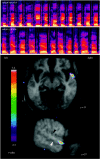Voice processing in human and non-human primates
- PMID: 17118926
- PMCID: PMC1764839
- DOI: 10.1098/rstb.2006.1933
Voice processing in human and non-human primates
Abstract
Humans share with non-human primates a number of voice perception abilities of crucial importance in social interactions, such as the ability to identify a conspecific individual from its vocalizations. Speech perception is likely to have evolved in our ancestors on the basis of pre-existing neural mechanisms involved in extracting behaviourally relevant information from conspecific vocalizations (CVs). Studying the neural bases of voice perception in primates thus not only has the potential to shed light on cerebral mechanisms that may be--unlike those involved in speech perception--directly homologous between species, but also has direct implications for our understanding of how speech appeared in humans. In this comparative review, we focus on behavioural and neurobiological evidence relative to two issues central to voice perception in human and non-human primates: (i) are CVs 'special', i.e. are they analysed using dedicated cerebral mechanisms not used for other sound categories, and (ii) to what extent and using what neural mechanisms do primates identify conspecific individuals from their vocalizations?
Figures



References
-
- Abberton E, Fourcin A. Intonation and speaker identification. Lang. Speech. 1978;21:305–318. - PubMed
-
- Aitkin L.M, Merzenich M.M, Irvine D.R, Clarey J.C, Nelson J.E. Frequency representation in auditory cortex of the common marmoset (Callithrix jacchus jacchus) J. Comp. Neurol. 1986;252:175–185. doi:10.1002/cne.902520204 - DOI - PubMed
-
- Allison T, Puce A, McCarthy G. Social perception from visual cues: role of the STS region. Trends Cogn. Sci. 2000;4:267–278. doi:10.1016/S1364-6613(00)01501-1 - DOI - PubMed
-
- Andrews M.L, Schmidt C.P. Gender presentation: perceptual and acoustical analyses of voice. J. Voice. 1997;11:307–313. doi:10.1016/S0892-1997(97)80009-4 - DOI - PubMed
-
- Assal G, Zander E, Kremin H, Buttet J. Discrimination des voix lors des lesions du cortex cerebral. Arch. Suisses Neurol. Neurochir. Psychiatry. 1976;119:307–315. - PubMed
Publication types
MeSH terms
LinkOut - more resources
Full Text Sources
Other Literature Sources

